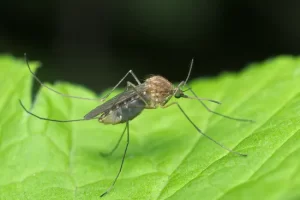Mosquito

Adults of the yellow fever mosquito Aedes aegypti, a typical member of the subfamily Culicin. The duration from egg to adult varies among species and is strongly influenced by ambient temperature.
Mosquitoes can develop from egg to adult in as little as five days but usually take 40 – 42 days in tropical conditions. The variation of the body size in adult mosquitoes depends on the density of the larval population and food supply within the breeding water.
Adult flying mosquitoes frequently rest in a tunnel that they build right below the roots of the grass.
Mosquitoes go through four stages in their life-cycle: egg, larva, pupa, and adult or imago. Adult females lay their eggs in standing water, which can be a salt-marsh, a lake, a puddle, a natural reservoir on a plant, or an artificial water container such as a plastic bucket. The first three stages are aquatic and last 5–14 days, depending on the species and the ambient temperature; eggs hatch to become larvae, then pupae. The adult mosquito emerges from the pupa as it floats at the water surface. Adults live for 4–8 weeks.
Adult mosquitoes usually mate within a few days after emerging from the pupal stage. In most species, the males form large swarms, usually around dusk, and the females fly into the swarms to mate.
Males live for about a week, feeding on nectar and other sources of sugar. Females will also feed on sugar sources for energy but usually require a blood meal for the development of eggs. After obtaining a full blood meal, the female will rest for a few days while the blood is digested and eggs are developed. This process depends on the temperature but usually takes 2–3 days in tropical conditions. Once the eggs are fully developed, the female lays them and resumes host seeking.
The cycle repeats itself until the female dies. While females can live longer than a month in captivity, most do not live longer than 1–2 weeks in nature. Their lifespan depends on temperature, humidity, and also their ability to successfully obtain a blood meal while avoiding host defenses.
While many species are native to tropical and subtropical regions, some such as Aedes have successfully adapted to cooler regions. In the warm and humid tropical regions, they are active the entire year long; however, in temperate regions they hibernate over winter. Eggs from strains in the temperate zones are more tolerant to the cold than ones from warmer regions. They can even tolerate snow and sub-zero temperatures. In addition, adults can survive throughout winter in suitable microhabitats.
Disease
The mosquito is a vector of malaria and mosquito control is a very effective way of reducing the incidence of malaria.
Mosquitoes are a vector agent that carries disease-causing viruses and parasites from person to person without catching the disease themselves. The principal mosquito borne diseases are the viral diseases yellow fever, dengue fever and Chikungunya, transmitted mostly by the Aedes aegypti, and malaria carried by the genus Anopheles. Though originally a public health concern, HIV is now thought to be almost impossible for mosquitoes to transmit. Mosquitoes are estimated to transmit disease to more than 700 million people annually in Africa, South America, Central America, Mexico and much of Asia with millions of resulting deaths. At least 2 million people annually die of these diseases.
Methods used to prevent the spread of disease, or to protect individuals in areas where disease is endemic include Vector control aimed at mosquito eradication, disease prevention, using prophylactic drugs and developing vaccines and prevention of mosquito bites, with insecticides, nets and repellents. Since most such diseases are carried by “elderly” females, scientists have suggested focusing on these to avoid the evolution of resistance.

